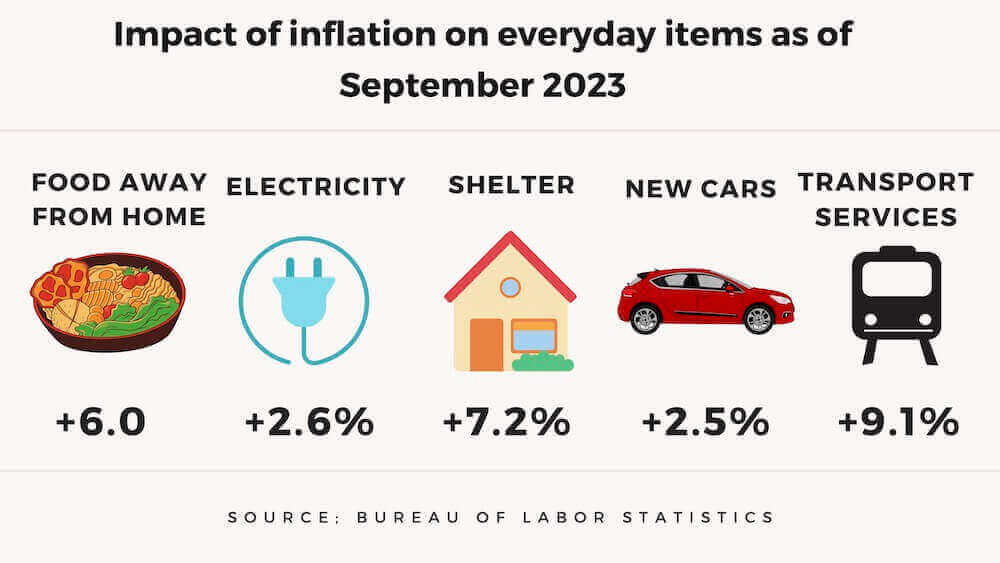December 2023 Inflation Report Issued
The Consumer Price Index for All Urban Consumers (CPI-U) increased 0.3% in December after rising 0.1% in November, according to the U.S. Bureau of Labor Statistics. The inflation rate increase was higher than had been anticipated.
Over the last 12 months, the all items index increased 3.4%.
Indexes that increased in December include shelter, motor vehicle insurance, and medical care. The index for household furnishings and operations and personal care decreased in December.
The latest inflation report indicates that while inflation has fallen considerably from a peak of 9.1%, it is still above the Federal Reserve’s 2% inflation target.
The latest report will probably not change Federal Reserve officials’ plan to hold their policy rate steady at their next meeting. Some analysts think interest rate cuts may occur after that if the monthly inflation rate increase remains low as inflation is nearing the 2% target sooner than economists had expected just a few months ago.
CPI-W Index for December
For many readers, the CPI-W index is the most significant. This index is used to calculate the annual COLA amount for the coming year. That amount of the next COLA is not calculated until the September data are released by the Bureau of Labor Statistics in October.
The COLA that goes into effect this month (January 2024) was calculated in October. There is a 3.2% cost-of-living adjustment for Civil Service Retirement System (CSRS) annuities, military retirement annuities, and Social Security benefits. There is a 2.2% COLA for Federal Employees Retirement System (FERS) annuities. The 2024 COLA is included in the January 2024 payments.
The 2024 COLA was significantly less than the 8.7% COLA effective in 2023.
The Consumer Price Index for Urban Wage Earners and Clerical Workers (CPI-W) increased 3.3% over the last 12 months. For the month, the index decreased 0.2%. The CPI-W figure for December 2023 was 0.017 lower than the average CPI-W for the third quarter of 2023.
The annual COLA is determined by comparing the change in the CPI-W from year to year, based on the average of the third-quarter months of July, August, and September.
Remember this when considering the 2025 COLA figure that will be announced in October: CSRS and Social Security COLAs are based on the annual change in the CPI-W. So are the FERS COLAs, but they are capped at 2% when the CPI-W increases between 2 and 3%. They are reduced by 1% when the CPI-W increases by 3% or more.
Comparing Federal Pay Raise and COLAs to Inflation Rate
A raise of any amount is generally well received and appreciated. The purchasing power created by a person’s income level is more important than the actual amount of the raise. For example, the 8.7% COLA that was effective in 2023 was the largest COLA payment since 1981 when it was 11.2%.
Here is a chart that compares how purchasing power may have been impacted:
| Year | Avg. Federal Pay Raise | COLA | Inflation |
| 2021 | 1% | 5.9% | 4.7% |
| 2022 | 2.7% | 8.7% | 6.5% |
| 2023 | 4.6% | 3.2% | 3.4% |
| 2024 | 5.2% | ? | ? |
The income from COLAs and pay raises for federal employees and retirees has been going up in the last several years. The purchasing power of this income has been going down.
The reality is that the increase in income comes after prices have already gone up. The 5.2% pay raise for federal employees in 2024 is the highest in 40 years but has been awarded after inflation has taken hold in the form of higher prices in the previous two years.
The reality is that the pay raise that is providing more dollars this year is arriving after the prices have gone up. So, for those going to the grocery store or paying rent or a mortgage who feel like they do not have as much money left to spend after paying the bills, that feeling may be accurate. With high inflation, prices tend to stay at a higher rate in stores. Even with the rate of the inflation increase receding, consumers still feel the impact of higher prices.
Of course, for those who have paid off their house and car and do not have a mortgage payment or a car payment, the extra money will go further.
The good news is that the rapid inflation is down from its highest point despite the latest increase. The higher interest rates may also start going down in the next several months.





